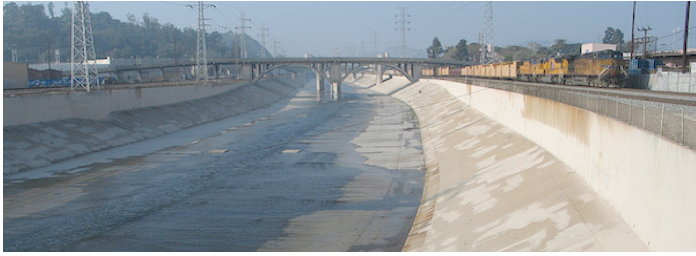GUEST WORDS-The back-story on how Mayor Eric Garcetti succeeded in winning $1 billion for the LA River Restoration is a fascinating lesson in politics. Simply put, President Barack Obama owed the mayor, and the president came through.
Back in 2007, Garcetti took a chance on Obama against the overwhelming liberal consensus on Hillary Clinton. Garcetti, while LA City Council President rode buses into the heat of Nevada to knock on doors for the long shot candidate, bringing LA volunteers with him. All that year, all over the country, Garcetti was one of Obama’s durable supporters. He repeated in 2012.
But when the 2013 mayor’s race came around, Obama wasn’t there for Garcetti in his battle with Wendy Greuel. Some of Obama’s best fund-raisers and top operatives did work for Garcetti while the president stayed out.
Therefore when Garcetti was elected, Obama was obligated. He opened the White House and agency doors to the young mayor, and listened attentively when Garcetti made plain his Big Ask: one billion dollars for the LA River.
Garcetti asked not once, but again and again. He called on California’s congressional delegation to weigh in. He sent hundreds of thousands of petitions. He and his team marshaled the complicated arguments over why the $500 million offered by the Army Corps of Engineers was not enough and why only $1 billion would do the job. One billion dollars for eleven miles of restoration on a dilapidated abandoned cement channel. One billion dollars amidst a political climate of austerity, at a time the president was supposedly thinking “small”.
How this agreement was navigated will be learned in the future. But two “no-drama” politicians played the political currents perfectly, setting the possible stage for one of the most important urban restorations in recent years. A legacy for Obama; a future for Garcetti.
It’s hard to imagine Los Angeles with a river running through it. The happy mayor is promising there will be “jackhammers on concrete” someday soon.
The vision and its possibilities brought emotion this week to many who fought for the vision years ago when it was considered hopeless. Poets like Lewis MacAdams; events with Mike Davis and Gary Snyder; and Judy Baca, SPARC, and kids painting The Great Wall. The community fights for parks instead of warehouses at the Cornfield and Taylor Yard. The expansion of the Santa Monica Mountains conservancy to the watershed and the birth of the San Gabriel River project. Out of the longer lost past came restored memories of the Great Park envisioned as the unifying center of Los Angeles in the 1930 Olmsted Report.
I remember campaigning on the river edge when my wife Barbara fell in back in 1997. There were many wild night car rides straight through the channel and its tunnels. Old folks could remember when they fished and inter-tubed there when they were young, before it was cemented almost to death by Public Works. In Sacramento, I had to smuggle $6.7 million into the state budget for River restoration when no one knew what it meant. Budget deals are based on compromise, and that’s how river funding began.
Los Angeles seemed doomed to be the only major North American city without a river running through it. Were we so singularly threatened by floods? That threadbare argument was replaced by stronger ones: the “cement channel” was a done deal; it was a crime and vandalism area; the marine life was beyond recovery.
The river was dead, officially. But it did not stop the restoration struggle, which became a fight for the identity of the city, against the lords of over-development who made congestion and pollution their ugly twins. Antonio Villaraigosa, while Speaker of the California Assembly, carried the bond measure that funded the early start, and campaigned all over LA promising to bring the river back from the dead. It became one of his most popular pledges while running for Mayor of Los Angeles.
Still Washington was not listening. Big “urban” projects were a hard sell in conservative times, especially with the government’s own experts belittling the river project. Even today, the $1 billion announcement does not sound possible coming from Washington, and more fights may lie ahead. The River project sounds like a small version of the New Deal, when the government helped develop so many of our parks and public buildings. Such big-spending programs were deemed unaffordable anachronisms by the billionaire real state barons.
The next stage will be difficult. Garcetti says he wants, “the good gentrification and not the bad,” but it’s inevitable that pressures of displacement will fall on the working class and poor communities who have lived along the river for decades. According to the Army Corps’ draft study, “much of Los Angeles is considered to be park deficient (with) access to parks…lowest in areas that have the highest number of families below the (household income line) of $47,331.” It would be a tragic repeat of LA’s land-use history if the small homeowners and taxpayers living along the channel’s edge are forced out to make room for a new destination zone for the affluent.
Voices in the environmental justice community, like the City Project’s Robert Garcia, are demanding a river with access to all. But it will take the same determination shown by Garcetti in fighting for the river funding in order to prevent a juggernaut of commercial and high-income development from turning the River project into a profitable bonanza when it can be a once-in-a-lifetime opportunity to green and make livable the quality of life for all Angelenos.
(Tom Hayden is a former state senator and leader of Sixties peace, justice and environmental movements. He currently teaches at Pitzer College in Los Angeles. His books include The Port Huron Statement [new edition], Street Wars and The Zapatista Reader. This column was posted originally at The Peace Exchange )
-cw
CityWatch
Vol 12 Issue 46
Pub: June 6, 2014





